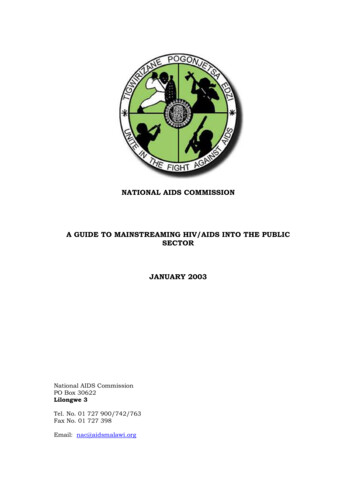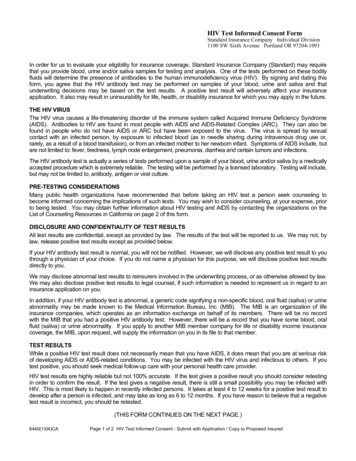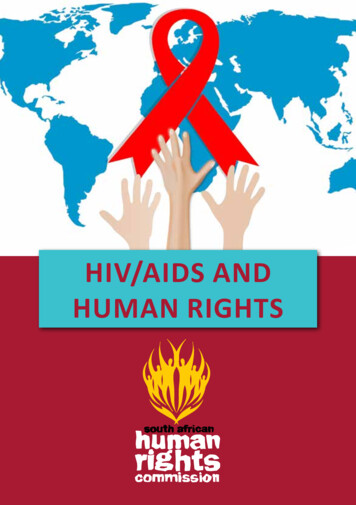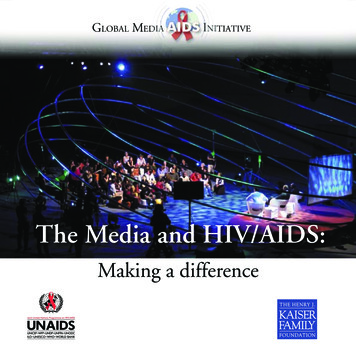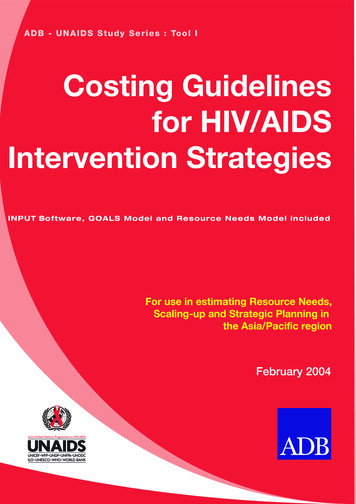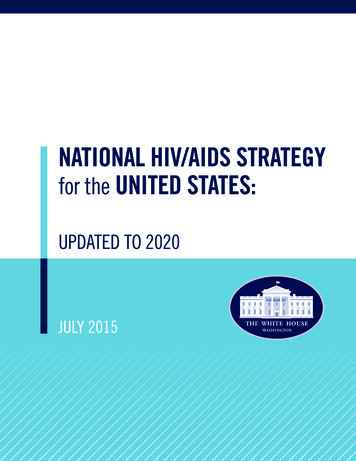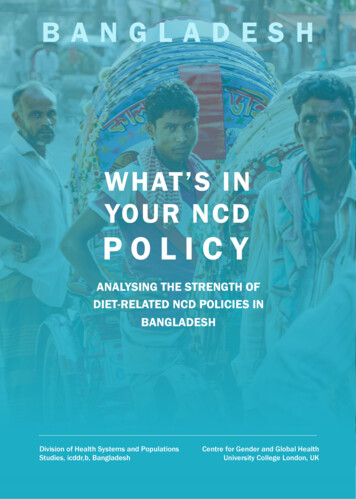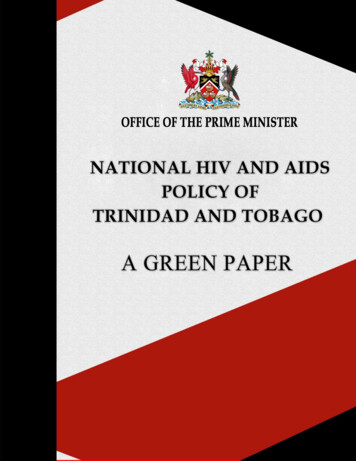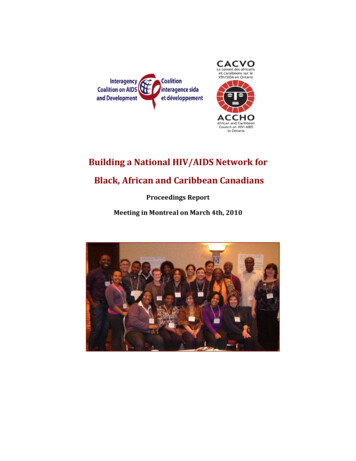
Transcription
Building a National HIV/AIDS Network forBlack, African and Caribbean CanadiansProceedings ReportMeeting in Montreal on March 4th, 2010
Building a National HIV/AIDS Network for Black, African and Caribbean CanadiansProceedings Report1.0 IntroductionICAD’s involvement in addressing HIV and AIDS within the African and Caribbean Diaspora has been aprogrammatic focus in recent years. To date we have worked with various stakeholders, including theAfrican and Caribbean Council on HIV/AIDS in Ontario (ACHHO) and have produced the followingresources: An environmental scan entitled “Springboarding a National HIV/AIDS Strategy for BlackCanadian, African and Caribbean Communities Environmental Scan Report”.“Taking Action on HIV and AIDS in Black Communities in Canada: A Resource for Moving Ahead”.‘Prevention Programs in Developed Countries: Lessons Learned: A Report on PreventionInitiatives used to address HIV and AIDS prevention for African, Caribbean and Black Populationsin developed countries’Following the publication of Taking Action, ICAD organized and hosted an invitation‐only, day‐longmeeting for key stakeholders including members of the Springboarding project national steeringcommittee, activists, policy makers, and provincial and federal government officials involved in thisissue. Following the event, ICAD and ACCHO published a final report which summarized the proceedingsand suggested the establishment of a national network to build on the work that has already beencompleted. This network would complement activities related to the government’s Federal Initiative toAddress HIV/AIDS among people from countries where HIV is endemic and further the work to addressHIV/AIDS in Black communities in Canada. The meeting recommended that the network includerepresentatives from existing regional/provincial bodies or hubs and new organizations establishedacross the country. This would support the engagement of different stakeholders, including Blackcommunity members connected to their local community, to bring forth and share information. It willalso lend an influential voice to HIV/AIDS issues in Black communities.2.0 Meeting Summary2.1On March 4, 2010, in a follow up to the above recommendations ICAD and ACCHO took the nextstep in the creation of a national network. With funding provided by the Public Health Agency of Canadaand ViiV , ICAD and ACCHO co‐hosted a one day, invitation only meeting entitled Building a NationalHIV/AIDS Network for Black, African and Caribbean Canadians in Montreal to coincide with the LeadingTogether: the 6th HIV/AIDS Skills Building Symposium. The event was facilitated by Beth Jordan fromAdobe Consulting Services and there were approximately twenty five participants in attendance. Theparticipants included relevant stakeholders from non‐governmental and community organizations,people living with HIV and AIDS and government representatives from the municipal, provincial andfederal level involved with African, Caribbean and Black communities across Canada. The purpose of theevent was to focus on governance and organizational issues relating to the network, to clarify its roleand to create the necessary infrastructure to sustain its existence.2
Building a National HIV/AIDS Network for Black, African and Caribbean CanadiansProceedings Report2.2Introductions were provided by Wangari Tharao from Women’s Health in Women’s Hands andValerie Pierre‐Pierre, Executive Director of ACHHO. Participants introduced themselves through a caféstyle meet and greet exercise and then reformed into the large group to discuss the goals and objectivesof the event. Participants were also invited to speak on how they felt about the meeting and manyexpressed excitement for the day’s proceedings and welcomed the opportunity to meet with othersfrom across Canada. Many also spoke to the challenges of stigma and isolation in their own communitiesand were glad to be part of a larger group that could provide support and the opportunity to discusstopics of mutual interest in a supportive environment. The goal of the event was to create and formalizea national network to facilitate the sharing of information and expertise and provide access to relevantresource materials. The National Network will also lend an influential voice to HIV/AIDS issues in Black,African and Caribbean Communities particularly in the area of policy, research and service delivery. Theobjectives of the event included: To contextualize the work that supports and/or has been done to date on a National Networkmodel and to share information on where the National Network has come from.To identify the role of a National Network by responding to key questions:1. Why do we need a National Network?2. What would be the role of a National Network?3. Who will participate in the Network and who would be targeted by the activities of theNetwork?To address issues of governance and infrastructure2.3To provide context for the participants Dionne A. Falconer provided a presentation of the eventsleading up to the meeting. The attendees broke into small groups and discussed at length ideassurrounding the role of the national network. Participants raised the following issues for consideration: The incredible diversity within Black, African and Caribbean communities in CanadaThe different needs of individuals based on the region in Canada in which they resideThe need to advocate for resources and disseminate relevant information on a national scaleThe possibility of building a surveillance network as part of the national networkThe possibility of linking the national network with other ethno‐cultural networks acrossCanadaIncreasing visibility within ACB communities: a national campaign with links to regional and localfocus and servicesChanging how the media portrays the ACB communitiesInforming policy decision making on a national level and providing a platform from which tochallenge such decisionsValidating the work of smaller organizations through their inclusion in the network, helpingthem with funding and facilitating the coordination of regional effortsCulturally adapted resources and approaches for service delivery3
Building a National HIV/AIDS Network for Black, African and Caribbean Canadians2.4Proceedings ReportThe group agreed to define the role of the network in the following manner:The ACB community in Canada is disproportionately affected by the HIV and AIDS epidemic. The role ofthe National Network is to provide leadership and to coordinate a national response to policy, researchand service delivery issues affecting the ACB community, identifying priorities and advocacy for theirinclusion at the national, provincial and community levels, facilitating the sharing of information andexpertise which accurately documents the ACB reality and, finally, to serve as a link between relevantnational and international networks and allies.2.5The group also discussed the limitations and parameters of a national network:1.2.3.4.5.6.7.Will be unable to direct service on the groundFunding will have to be foundMay be difficult to establish prioritiesHow to define the membershipPopulation Dispersal in CanadaFollowing through on decisions made by the networkThe need to be strategic in the outcomes of the networkDespite these challenges it was felt that once the foundational pieces were in place the network wouldbe able to be set up and grow. It was also expressed that consensus may not always be possible but thatthe network would seek to adopt a framework of conflict resolution for such instances and keep workingtowards the ‘role’ as outlined above.2.6The participants broke into small groups againto discuss the infrastructure of the network. Thisdiscussion was guided by the ICAD document WhatMakes a Network Work? which provides examples offive ‘model’ types of networks. Each group reportedback their opinions of the best type of model for thisnetwork. The group decided that at this stage thenetwork would be best served by a governing councilto be appointed by seeking volunteers from themeeting. The group also asked that ICAD temporarilyhouse the network and support its evolution until such time as it can be self sustaining or form newpartnerships with provincial hubs to coordinate its efforts. Membership was also discussed and somepresent felt that there could be two categories of membership within the network. The first categorywould consist of the aforementioned ‘governing council’, who would actively seek to drive thedevelopment of the network by drafting terms of reference, membership guidelines and other networkdocuments. The second category would encompass a more general membership for those who wouldlike to be a member of the network but may not have time or resources to dedicate to its further4
Building a National HIV/AIDS Network for Black, African and Caribbean CanadiansProceedings Reportdevelopment. This suggestion was approved in principal by the group and may be revisited at a laterdate.2.7The group also discussed the guiding principles for the network and highlighted the following asimperative: GIPA and MIPAAnti‐oppression, anti‐racism, anti‐homophobiaCommitted to working in each provinceCulturally competent and accessible to the whole communityInclusion and DiversityEquity and social justiceCollaboration and partnershipAccountability and TransparencyAccessibilityCommunity driven (By Us, For Us)Harm ReductionIt was also felt by some members that community and youth engagement would also need to playstrong roles within the framework thought how this will be defined requires further discussion.2.8Finally, the group considered broad strategies to guide the content of future meetings of thegoverning council and charged the council with drafting the terms of reference for the network inconjunction with the organizing committee for the March 4th event. Suggested considerations included:1.2.3.4.5.6.7.To finalize the operational and governance structure.To establish the guidelines for a communication strategy.To create a strategic plan with a monitoring and evaluation framework.Research, policy and advocacy strategies.To create a coordination mechanism between formal and informal networks.Planning to have meetings across Canada.Facilitate the wider dissemination of the progress of the council relating to the creation ofinformation and challenges.2.9Volunteers were invited to join the governing council. The following are the approved membersof the Governing Council:1. Irene MlamboSomerset West Community Health CentreOttawa, ON2. John GayeAfrican Diaspora Association of the Maritimes Halifax, NS3. Lynn SutankayoHIV EdmontonEdmonton, AB4. Joseph Jean‐GilesGAP‐VIESMontreal, PQ5. Valerie Pierre‐PierreACCHOToronto, ON6. Alain HoudePublic Health Agency of CanadaOttawa, ON(ex‐officio member)7. Robert BardstonHIV Society of South Eastern AlbertaMedicine Hat, AB5
Building a National HIV/AIDS Network for Black, African and Caribbean Canadians8. Elisa Hatton9. Rosemary Forbes10. Wangari TharaoBlack CAPICADWomen’s Health in Women’s HandsProceedings ReportToronto, ONOttawa, ONToronto, ON3.0 Next StepsThe meeting created a formal space for organizational and theoretical considerations to be assessed bymembers of the community. The network will now rely on the organizing committee and the governingcouncil to complete the following tasks to ensure that the momentum created at the meeting continues.The group outlined the following next steps:1. The Organizing committee will draft terms of reference and suggest a formal name for thenetwork. These will be sent to the appointed governing council for review and final approval.2. The organizing committee will hand over responsibility for the network to the governing councilat a final meeting.3. The governing council will formulate a strategy to officially launch the network on a nationalscale. As part of this process the council will formulate a communications strategy to supportthe network.4. The network will actively seek out to build the membership of the network from within ACBcommunities.The meeting discussed the need for a national organization to help support the network in these nextfew months as the foundations are laid. The Interagency Coalition on AIDS and Development was askedto fulfill this role until such time that an ACB organization from within the network gained the capacityto do so.Closing remarks were offered by Wangari Tharao who thanked everyone for attending. The group wasalso informed that an evaluation questionnaire would be sent by e‐mail to all participants.6
Building a National HIV/AIDS Network for Black, African and Caribbean CanadiansProceedings ReportParticipants ListAlain HoudePHACOttawa, ONIrene MlamboSomerset West Community Health CentreOttawa, ONAlexis MusanganyaArc‐En‐Ciel d'AfriqueMontreal, QCJohn GayeAfrican Diaspora Association of the MaritimesHalifax, NSAngeline JonesICADOttawa, ONJoseph Jean‐GillesGAP‐VIESMontréal, QCCarlos IdibouoArc‐En‐Ciel d'AfriqueMontreal, QCLynn SutankayoHIV EdmontonEdmonton, ABEric BigirimanaCOCQ‐SIDAMontréal, QCMaryStella AnidiSexuality Education Resource CentreWinnipeg, MBDaniel TownsendGlobal Youth Coalition on HIV/AIDSToronto, ONNicci SteinICADOttawa, ONDawn ShepherdPHACQuebec RegionRobert BardstonHIV Society of South Eastern AlbertaMedicine Hat, ABDionne A. FalconerDA Falconer and Associates Inc.Toronto, ONRosemary ForbesICADOttawa, ONDr. Alix AdrienMcGill UniversityMontreal, QCSusanna Ogunnaike‐CookePHACOttawa, ONElisa HattonBlack CAPToronto, ONValérie Pierre‐PierreACCHOToronto, ONFelicite MurangiraACHNOOttawa, ONWangari TharaoWomen’s Health in Women’s Hands CHCToronto, ON7
Interagency Coalition on AIDS andDevelopment (ICAD)African and Caribbean Councilon HIV/AIDS in Ontario1 Nicholas Street, Suite 726,Ottawa ON K1N 7B7110 Spadina Ave., Suite 207Toronto Ontario M5V 2K4Telephone:(613) 233 7440Telephone:(416) 977 9955Fax:(613) 233 8361Fax:(416) cisd.com
Building a National HIV/AIDS Network for Black, African and Caribbean Canadians Proceedings Report 4 2.4 The group agreed to define the role of the network in the following manner: The ACB community in Canada is disproportionately affected by the HIV and AIDS epidemic.

